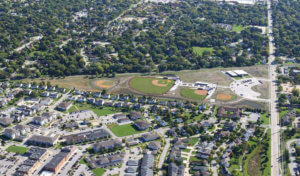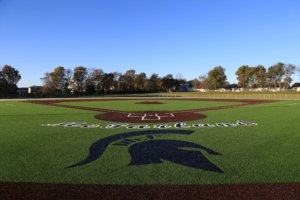High School Athletics Participation at All-Time High
According to a recent survey by the National Federation of State High School Associations (NFHS), over 7.9 million U.S. students currently participate in high school athletics, breaking previous records for the 29th consecutive year. As participation and support for every sport, from soccer and football to lacrosse and track and field, continues to grow, so do the needs and expectations for athletic facility design.
“High school athletic facilities are being used more than ever before, and not just for sporting events,” states Clay Schneckloth, Landscape Architect for Snyder & Associates. “They’re a hub of community activity, and new demands and challenges come with that.” Fortunately, industry trends that are both innovative and affordable have evolved to ensure high school athletic facilities are as user- and spectator-friendly as the large, professional stadiums that many student-athletes aspire to play in.
Alternative Turf Options Create a Better Playing Surface
The athletic playing field is simply the grassy backdrop of heated rivalries and historic victories for many spectators. We often don’t stop to think of how the quality of the turf and field treatments can impact the game.
Most high school athletic fields are built on native soil, typically high in silt and clay, with a low infiltration rate. Unable to absorb rain, native soil fields can become saturated and muddy when wet, which reduces traction and stability. Poor athletic field conditions combined with heavy use can cause natural grass failure and game cancellations until the field recovers.
As a result, some schools are switching to alternative turf options, such as synthetic turf or sand-capped fields. With a synthetic field, there’s no need to worry about stress on the turf, but it’s also quite expensive, notes Schneckloth. Sand-capped fields, on the other hand, provide a popular, cost-effective turf alternative, allowing the field to drain quickly and withstand frequent use by adding four inches of sand and topsoil mix right below the turf surface. On projects where natural grass turf is preferred, Schneckloth and his colleagues focus on seven aspects of natural turf design that guide grass health and establishment.
Bright Evolution of Lighting Technology
For decades, large, metal halide lights (with all their shortcomings) have loomed over high school athletic facilities, boldly illuminating the field long after nightfall. However, as LED technology becomes more affordable — professional sports stadiums are switching in droves, with high school athletic fields following suit. “LEDs are still more expensive initially, but the cost of long-term maintenance is lower, and they offer greater longevity and increased functionality,” says Schneckloth.
Requiring at least five minutes until metal halide lights fully warm up and reach maximum brightness, the energy consumed and wasted is relatively high. LED lights, with a reported energy savings of 65 to 85 percent, turn on instantly. In addition, they offer a more uniform source of light akin to sunlight, which increases safety, visibility, and broadcast quality.
Touting a host of benefits, the use and popularity of LED technology on high school athletic fields isn’t limited just to field lights. With the ability to do animations, replays, and advertising, “many school districts are also switching to LED scoreboards,” he mentioned.
Coordinated and Theme-Based Athletic Facility Design
Dull, cold concrete blocks, and plain steel athletic facilities are also becoming a thing of the past as more emphasis is given to creating warm, inviting community spaces. “From a finishing standpoint, a custom theme throughout the facility is something to strive for,” states Schneckloth. “By introducing new elements and amenities, a much more appealing environment can be achieved through an attractive athletic facility design.”
To do so, logos and team colors are increasingly part of the finished design for benches, trash receptacles, and signage. Vinyl-coated or decorative picket fencing is used instead of a standard galvanized fence. “You’ll also see these upgrades in the concessions areas and restrooms,” says Schneckloth. “The sterile block restroom is a thing of the past that most districts are moving away from. Most of the workers in the concession stand are parents and volunteers. The schools want to provide a little better experience for them, as well, because they’re giving their time to support the school.”
Including even a few of these small elements can stir the patrons’ emotions, creating a more memorable experience overall. Little details can go a long way in making a unique space people enjoy and a source of community pride. “Even something as simple as decorative concrete or pedestrian pathway lighting can make a major difference,” he says.
Enhanced Spectator Experience and Fan Amenities
As the number of students participating in high school sports increases, so do the number of spectators and the time they spend at athletic facilities. This can range from a few hours to an entire weekend in the event of a tournament. “Providing amenities that allow people to relax and enjoy themselves is a nice feature and enhances the spectator experience,” says Schneckloth.
Additionally, social sharing has become a way for people to stay connected and share their experiences. As fans record and share game-winning plays and memorable moments, in-stadium amenities such as Wi-Fi and phone charging stations have quickly become must-have features. Users can quickly and easily connect by incorporating these elements into the press box or light pole locations.
Common Areas & Trail Access Add Value & Functionality
Playground equipment and plaza areas where people can congregate away from the game action and out of elements provide added value and functionality. Playgrounds and outdoor park areas allow families with children to take a break from the confining bleachers and run, jump, and move around. In addition, shade trees and canvas canopies can be placed throughout the venue to create smaller spaces for groups to gather. Social gathering spaces allow people to mingle and relax while remaining close to the game.
Traffic before and after games is a frequent concern. To support equitable mobility to and from the game, trail connectivity has become a routine request for many communities. While trail access promotes a healthy lifestyle, careful design can promote economic and environmental benefits. Incorporating multimodal connections can maximize the use and value of your facility.
“As the needs and expectations of your current sports facility change, our team is prepared to make recommendations on incorporating the latest design trends that will best suit your long-term needs,” shares Schneckloth. “Our goal is to design safe and top-performing high school athletic facilities, and we do this by providing sound planning and guidance for our clients.”


